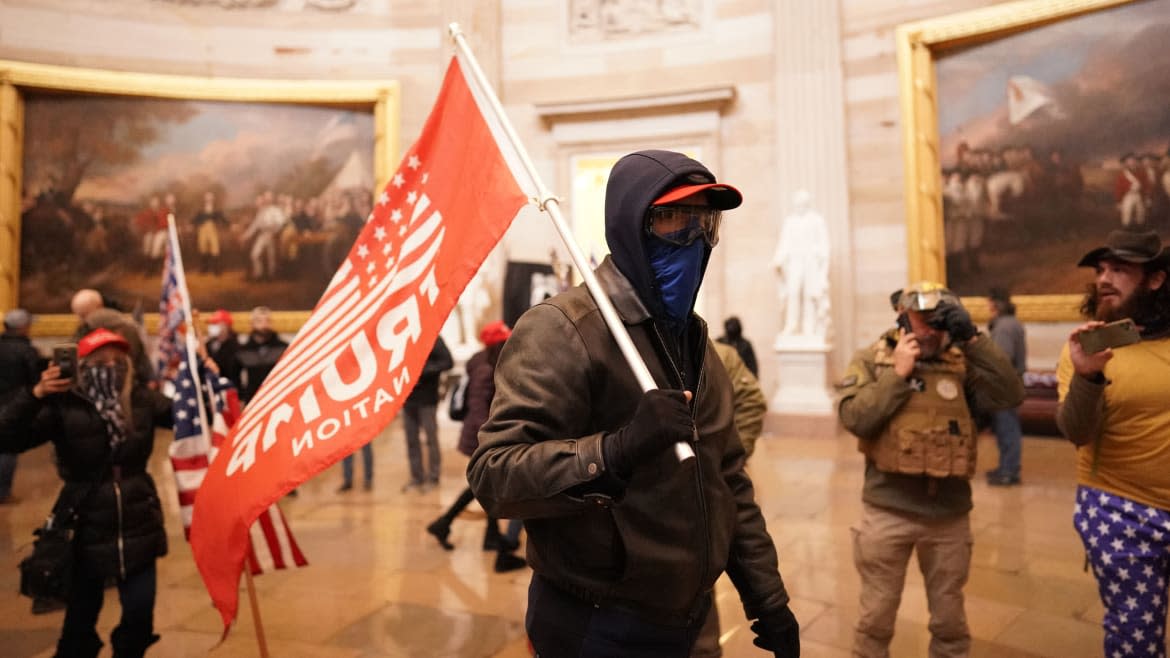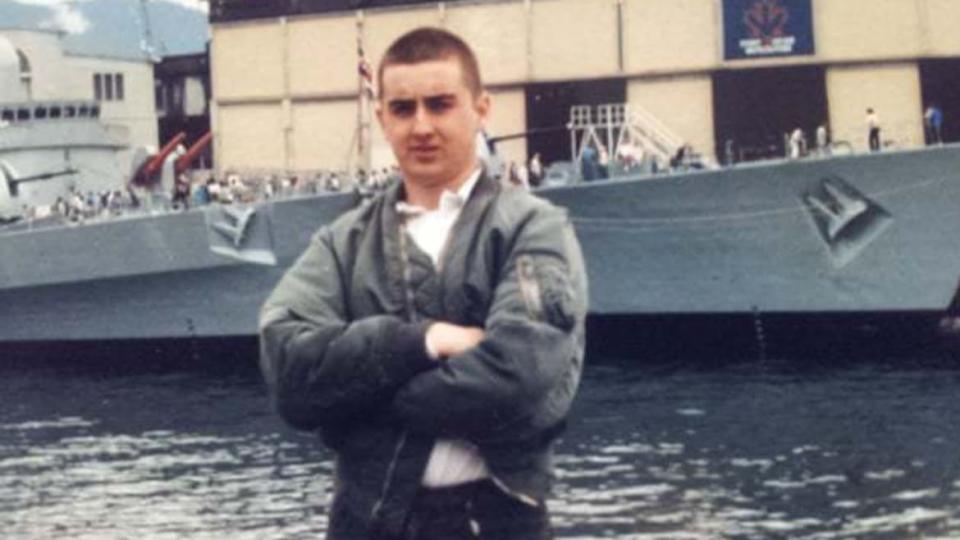A Former Neo-Nazi’s Guide to Deprogramming Trump Cultists

There are times in the history of a nation that are watershed moments, events after which the nation will never be the same again. These moments grab the national psyche and shake it, rattle it—leaving an indelible stain behind. A national trauma. Sadly, there have been too many of these moments in the last decade: from the murder of George Floyd in Minneapolis, Heather Heyer in Charlottesville, or the congregants of the Emanuel AME Church in Charleston, the Tree of Life Synagogue in Pittsburgh, or the Sikh Temple in Oak Creek, Wisconsin.
The riot and storming of the Capitol on Jan. 6 (which, as of writing, has left five dead) was not a specifically racially motivated attack on people (although the mob included those who betrayed their true intention with Confederate flags) but, rather, a politically motivated attack on democracy. It took what was a schism in our society and turned it into a chasm—and if we cannot learn to bridge that chasm, will lead to further division, violence, and the real potential of civil war.
Watching the events unfold live on television, the way the crowd surged toward and into the Capitol, and the look of bewilderment on the faces of those who had no idea what to do next beside those filled with rage, I recalled times in my past where I was caught up in the emotion of the moment. The rush of adrenaline that conflict and violence delivered in exhilarating doses, fight or flight kicking in as blood flow to higher brain function is cut off, and the ability to reason has gone out the window. I remember believing in something so much that dying was a fair price to pay for its success—and there was no shortage of older movement leaders to take advantage of such blind enthusiasm.

The author as a young neo-Nazi
I had bought into an ideology that believed the white race faced an existential threat, and the world as I knew it was fated to be crushed by a rising tide of other races and cultures. I didn’t just buy into this—as I rose through the ranks of the white nationalist movement, I sold the ideology to others, and the promise of glory and a permanent place in history for those who prevented the “impending white genocide.” That promise was both seductive and intoxicating, especially to a young man searching for meaning and significance, like I was. That promise turned out to be false, so full of holes and riddled with so many contradictions that I am ashamed to admit them today.
In belonging to a violent neo-Nazi group dedicated to the fantasy of a heroic struggle to turn back the tides of time, to survive what I believed be an existential threat to the white race, to go from zero to hero… all of it made me feel powerful. The feeling of being a part of a movement of something much bigger than myself. The camaraderie and brotherhood made me feel wanted and accepted. Most of all, it made me feel important. The toxic ideology wasn’t just the ideas that I believed in—it became my identity. Not only who I was, but also who I hung out with, what I read, listened to, and watched. Even my clothing was meant to signal to the world who my tribe was because, without all the bluster and attention-seeking, I felt very, very small. Invisible. Impotent.
Today, in a similar fashion, we see the stark symbolism among Trump fanatics: the flags, the colors, the hats, the badges and slogans fashioned to unite a cause and submerge the identity of the individual.
See an exclusive clip of former neo-Nazis convening in ‘Healing from Hate’:
So, how do you get through to someone holding extremist views and facilitate change? Intuitively, the first impulse is to attack the facts and opinions they hold with logic and reason. The challenge is that ideology and identity are intertwined, and when we attack ideology, we also attack identity—literally who they feel themselves to be. Once ego defense mechanisms have kicked in, change is very difficult, if not impossible. Instead, the key is to go in through the heart—it can’t be done without human connection.
When we create a safe space and listen without judgment, it allows others to open up and for walls to begin to come down. When we are genuinely curious as to who someone is, and why they believe what they believe, this non-judgmental space can help to dissolve the armor of ego and identity. We can despise the ideology and the actions, but we should never despise the human being. No one is irredeemable. Every single “former,” like myself, has a story with this same basic theme—of having been extended compassion by someone when we least deserved it. It has the power to transform, something I can personally attest to. In times like these, when anger and division are stoked, this approach may feel all too soft. But people want, and need, to be truly heard and seen—the absence of which is something I believe lies at the root of hate-group affiliation and activity. Now that Trump is gone, the feeling of disenfranchisement remains—the same sentiment that allowed for the ascendancy of Trump in the first place. If we ignore that sentiment, Trump voters will remain vulnerable to another (potentially more sophisticated, and therefore dangerous) Pied Piper to seduce them with false promises. Right now, however, there is a tremendous opportunity—an opportunity that can open the door to sober reflection.
When we listen, whether rational or not, there is often a perceived grievance. We may disagree with it, and it may be grounded in a false sense of entitlement, loss or relative deprivation, but it is very real to them. Of course, no one can feel heard when being yelled at, judged, or shamed—so it’s crucial to suspend our desire to do just that, as if talking to a friend or relative. (If you want to understand better how this works, practice having a conversation with a friend where neither of you can make statements, but only ask questions). Difficult, perhaps. But at the end of the day we need to ask ourselves: Do we want to affect change, or do we want to be right? It appears unlikely that any steps toward healing will be coming from Trump himself, as the former president departs for Mar-a-Lago with little indication of looking back. Embittered and withdrawn, he appears incapable of it. For better or worse, that leaves the burden on all of us, once again. And if not us, then who?
Arguably the most powerful scene in Healing From Hate: Battle For the Soul of a Nation—a newly released documentary that features the work of Life After Hate, an organization I helped to form—involves Randy, a skinhead wearing a swastika T-shirt, on his way to see white nationalist Richard Spencer speak in Florida. We witness Randy walk through a crowd of protesters who are kicking, punching, cursing, and spitting on him. With each blow, Randy becomes more defiant and determined. A young African-American man named Julius intervenes to usher Randy safely away from the angry crowd, and asks if they can talk. That dialogue developed into a friendship that exists today, and Randy has left the movement behind. On the face of things, these two men seem the most unlikely people to become friends—but their dialogue continues. We must call people out and hold them accountable, but it’s also essential that we’re prepared to call people in. It’s important to point out here that it is not the responsibility of people of color or marginalized communities to step up and take this on as Julius did—but if he can do it, then what is our excuse for not following his courageous example? If it is indeed up to us, then we must engage disillusioned Trump supporters and offer them a path back. We must try, lest we allow them to be drawn into deeper and darker places.
He Was the Neo-Nazi Who Inspired ‘American History X.’ His Nazi Pals Are Now Cops.
In the course of filming Healing From Hate, I was also given the opportunity to visit the Oak Creek Temple and meet with Amardeep Kaleka, the son of murdered Temple President Satwant Singh Kaleka. There, to commemorate the one-year anniversary of the tragic mass shooting that claimed the lives of six congregants, the Sikh community placed seven gold domes atop the Temple. Six of those represented the victims, the seventh the shooter himself—the one requiring the most prayer. Even in tragedy they were able to see the humanity in that person.
If we are to be the compassionate society that we claim to want to be, then great courage is in order to be the change we seek. We are beyond the time when society’s divisions can be solved from within our comfort zone. We must be prepared to listen without judgment, without the need to be right, in order to arrive at understanding—the foundation from which reconciliation, healing, and eventually, unity can emerge. Compassion—when married with healthy boundaries and consequences that holds people accountable—can be a powerful equation.
Healing From Hate shows how transformative that experience can be, and the countless people helped by Life After Hate further prove that transformation and healing in those that seem irredeemable is possible. The hardest thing in the world to do is to have compassion for those who don’t have any—but aren’t those the ones who need it most?
Tony McAleer, author of The Cure For Hate: A Former White Supremacist’s Journey from Violent Extremism to Radical Compassion, is featured in the documentary Healing From Hate: Battle for the Soul of a Nation, which comes out on demand on Jan. 22. He found an outlet for his teenage rage in the street violence of the skinhead scene. He then grew deeply involved in the White Aryan Resistance (WAR), rising through the ranks to become a leader, and embraced technology and the budding internet to bring white nationalist propaganda into the digital age. After fifteen years in the movement, it was the outpouring of love he felt at the birth of his children that inspired him to start questioning his hateful beliefs. Thus began the spiritual journey of personal transformation that enabled him to disengage from the highest levels of the white power movement. Today, Tony is an international speaker, change-maker, and loving father of two. As co-founder of the nonprofit organization Life After Hate, he has made it his mission to help people leave hate groups.
Get our top stories in your inbox every day. Sign up now!
Daily Beast Membership: Beast Inside goes deeper on the stories that matter to you. Learn more.

 Yahoo News
Yahoo News 
